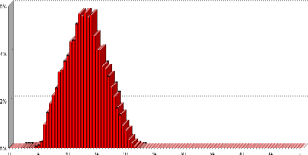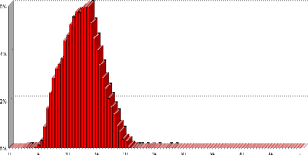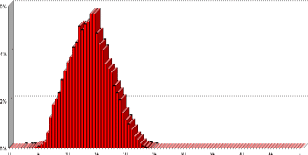|

The DM+9, just as all other DiamondMax Pluses, incorporates a 7200 RPM spindle speed. Maxtor specifies an average read seek times of 9.4 milliseconds. The family as a whole incorporates a bewildering amount of options. In addition to platter densities, the drives come equipped with either ball bearing or the newer and quieter fluid dynamic bearing motors. Buffer size may be either 2 or 8 megabytes. Maxtor offers DM+9’s in a boxed retail package under the “Ultra” moniker, which come equipped with FDB motors and an 8-megabyte buffer. Those users ordering bare units from specialty resellers should, however, double check to ensure that they know exactly what kind of drive they should expect to receive.
Succeeding the DiamondMax D740X, the DM+9 is Maxtor’s entry into the high-performance desktop drive arena. Currently, the drive comes in the traditional parallel ATA format with an ATA-133 interface. Maxtor eventually plans to offer Serial ATA versions of the drive. SR has received varying reports from readers regarding Maxtor’s current warranty policy. According to the manufacturer itself, however, all DM+9s are backed by a one-year warranty. Maxtor is rolling out a separate line, the Maxline Plus, that incorporates similar mechanics but is backed by a longer three-year policy.

We have little doubt that Maxtor will eventually reach a point after which all DM+9s will ship with 80 GB platters. Unfortunately, we cannot present to readers an easy way to discern what kind of configuration they may expect when purchasing one today. Maxtor, like Western Digital, is moving away from discrete platter densities within a given family. The firm states that fierce competition and the resulting razor-thin margins have forced it to adopt this strategy.
Low-Level ResultsFor diagnostic purposes only, StorageReview measures the following low-level parameters: Average Read Access Time– An average of 25,000 random accesses of a single sector each conducted through IPEAK SPT’s AnalyzeDisk suite. The high sample size permits a much more accurate reading than most typical benchmarks deliver and provides an excellent figure with which one may contrast the claimed access time (claimed seek time + the drive spindle speed’s average rotational latency) provided by manufacturers. WB99 Disk/Read Transfer Rate – Begin– The sequential transfer rate attained by the outermost zones in the hard disk. The figure typically represents the highest sustained transfer rate a drive delivers. WB99 Disk/Read Transfer Rate – End– The sequential transfer rate attained by the innermost zones in the hard disk. The figure typically represents the lowest sustained transfer rate a drive delivers. |
For more information, please click here.
|
Note: Scores on top are better. |
|
||
Maxtor DiamondMax Plus 9 60 GB/platter Average Read Service Time
|
||
Maxtor DiamondMax Plus 9 68 GB/platter Average Read Service Time |
Maxtor DiamondMax Plus 9 80 GB/platter Average Read Service Time |
|
With their varying densities, the three different DiamondMax Plus 9’s turn in a smattering of access times. The fastest is the 68 GB/platter unit with its measured access time of 12.4 milliseconds. Remember that this unit is effectively a 200-gigabyte drive that’s been “partitioned” down to 160 GB. Next is the 60/GB platter unit. Its score of 13.0 milliseconds reflects its slightly short-stroked construction as well. Bringing up the rear is the 80 GB/platter drive with a score of 13.8 milliseconds. Subtracting 4.2 milliseconds to account for the average rotational latency of a 7200 RPM drive yields measured average seek times of 8.2 ms (68 GB), 8.8 ms (60 GB), and 9.6 ms (80 GB). All more or less meet or beat Maxtor’s 9.4 ms claim.
The use of an external controller (the Promise Ultra133) and its associated driver unfortunately makes it more difficult to consistently disable write caching which unfortunately precludes us from presenting average write access times.
|
Note: Scores on top are better. |
|
|||||||||||||||||||||||||||||||||||||||
|
|
||||||||||||||||||||||||||||||||||||||
- Maxtor DiamondMax Plus 9 60 GB/platter Transfer Rate Graph
- Maxtor DiamondMax Plus 9 68 GB/platter Transfer Rate Graph
- Maxtor DiamondMax Plus 9 80 GB/platter Transfer Rate Graph
As one might expect, the 80 GB/platter unit tops the transfer rate charts with an outer-zone transfer rate of 59.2 MB/sec. The 68 GB/platter drive and 60 GB/platter unit weigh in respectively at 55.4 and 53.2 MB/sec. The short-stroked nature of the latter two drives, however, permits them less “decay” in rates as tests move towards the inner sections of the drive. When it comes to inner-zone scores, it’s the 80 GB drive that brings up the rear.
Single-User PerformanceStorageReview uses the following tests to assess non-server use: StorageReview.com Office DriveMark 2002– A capture of 30 minutes of actual computer productivity use that exactingly recreates a typical office-style multitasking environment. The applications include: Outlook XP, Word XP, Excel XP, PowerPoint XP, Calypso (a freeware e-mail client), SecureCRT v3.3 (a telnet/SSH client), CuteFTP Pro v1.0 (an FTP/SSH client), ICQ 2000b), Palm Hotsync 4.0, Gravity 2.3 (a Usenet/newsgroups client), PaintShop Pro v7.0, Media Player v8 for the occasional MP3, and Internet Explorer 6.0. StorageReview.com High-End DriveMark 2002– A capture of VeriTest’s Content Creation Winstone 2001 suite. Applications include Adobe Photoshop v5.5, Adobe Premiere v5.1, Macromedia Director v8.0, Macromedia Dreamweaver v3.0, Netscape Navigator v4.73, and Sonic Foundry Sound Forge v4.5. Unlike typical productivity applications, high-end audio- and video- editing programs are run in a more serial and less multitasked manner. The High-End DriveMark includes significantly more sequential transfers and write (as opposed to read) operations. |
StorageReview.com Bootup DriveMark 2002– A capture of the rather unusual Windows XP bootup process. Windows XP’s boot procedure involves significantly different access patterns and queue depths than those found in other disk accesses. This test recreates Windows XP’s bootup from the initial bootstrap load all the way to initialization and loading of the following memory-resident utilities: Dimension4 (a time synchronizer), Norton Antivirus 2002 AutoProtect, Palm Hotsync v4.0, and ICQ 2000b.
StorageReview.com Gaming DriveMark 2002– A weighted average of the disk accesses featured in five popular PC games: Lionhead’s Black & White v1.1, Valve’s Half-Life: Counterstrike v1.3, Blizzard’s Diablo 2: Lord of Destruction v1.09b, Maxis’s The Sims: House Party v1.0, and Epic’s Unreal Tournament v4.36. Games, of course, are not multitasked- all five titles were run in a serial fashion featuring approximately half an hour of play time per game.
For more information, please click here.
|
Note: Scores on top are better. |
|
|||||||||||||||||||||||||||||||||||||||
|
|
||||||||||||||||||||||||||||||||||||||
|
|
||||||||||||||||||||||||||||||||||||||
Interestingly, it is not the drive with the highest transfer rates (80 GB/platter) nor the one with the swiftest access times (68 GB/platter) that turns in the highest StorageReview.com Office DriveMark. Rather, it’s the “lowly” 60 GB/platter DM+9 at 397 I/Os per second that takes the honor for the trio. Note, however, that all three drives nonetheless score very similarly. It is doubtful that users would be able to discern the difference.
The SR High-End DriveMark is a bit more transfer rate intensive than the Office suite- the 80 GB/platter unit manages to edge past the 60 GB/platter drive.
It is in the Bootup DriveMark, a rather unusual test that incorporates higher-than-normal queue depths where significant differences emerge. While the 80- and 60-gig units turn in similar scores, the 68 GB/platter DM+9 stumbles and falls significantly behind the other drives.
All three drives return to parity in the Gaming DriveMark.
In all of these application-level desktop benchmarks, regardless of areal density, the DM+9 cannot quite keep up with Western Digital’s Caviar WD2000JB.
Multi-User PerformanceStorageReview uses the following tests to assess server performance: StorageReview.com File Server DriveMark 2002– A mix of synthetically-created reads and writes through IOMeter that attempts to model the heavily random access that a dedicated file server experiences. Individual tests are run under loads with 1 I/O, 4 I/Os, 16 I/Os, and 64 I/Os outstanding. The Server DriveMark is a convenient at-a-glance figure derived from the weighted average of results obtained from the four different loads. StorageReview.com Web Server DriveMark 2002– A mix of synthetically-created reads through IOMeter that attempts to model the heavily random access that a dedicated web server experiences. Individual tests are run under loads with 1 I/O, 4 I/Os, 16 I/Os, and 64 I/Os outstanding. The Server DriveMark is a convenient at-a-glance figure derived from the weighted average of results obtained from the four different loads. For more information click here. |
|
Note: Scores on top are better. |
|
|||||||||||||||||||||||||||||||||||||||
|
|
||||||||||||||||||||||||||||||||||||||
Despite the fact that it must work across the entire breadth of its platters, the 80 GB/platter DiamondMax Plus 9 turns in marginally better scores than its two brethren. In any case, however, it is surprising to note that regardless of their relatively swift access times, the DM+9s turn in rather anemic server scores when contrasted with the competition.
Legacy PerformanceeTesting Lab’s WinBench 99 Disk WinMark tests are benchmarks that attempt to measure desktop performance through a rather dated recording of high-level applications. Despite their age, the Disk WinMarks are somewhat of an industry standard. The following results serve only as a reference; SR does not factor them into final judgments and recommends that readers do the same. |
|
Note: Scores on top are better. |
|
|||||||||||||||||||||||||||||||||||||||
|
|
||||||||||||||||||||||||||||||||||||||
Heat and NoiseIdle Noise– The sound pressure emitted from a drive measured at a distance of 18 millimeters. The close-field measurement allows for increased resolution between drive sound pressures and eliminates interactions from outside environmental noise. Note that while the measurement is an A-weighted decibel score that weighs frequencies in proportion to human ear sensitivity, a low score does not necessarily predict whether or not a drive will exhibit a high-pitch whine that some may find intrusive. Conversely, a high score does not necessarily indicate that the drive exhibits an intrusive noise envelope. Net Drive Temperature– The highest temperature recorded from a 16-point sample of a drive’s top plate after it has been under heavy load for 80 minutes. The figures provided are net temperatures representing the difference between the measured drive temperature and ambient temperature. For more information, please click here. |
|
Note: Scores on top are better. |
|
||||||||||||||||||||||||||||||||||||
|
|
|||||||||||||||||||||||||||||||||||
All three DiamondMax Plus 9 samples feature fluid dynamic bearing motors. As a result, it is unsurprising that all three drives turn in low idle noise scores in our objective measurements. As one would expected, the 2-platter, 80 GB/platter drive is quietest- its noise floor approaches that of Seagate’s latest Barracudas. The 3-platter, 60 GB/platter unit weighs in slightly louder, but is still very quiet. Finally, the 3-platter, 68/GB platter drive turns in a score a bit higher than its two brothers. Subjectively speaking, the drive emitted an ever-so-slight low-pitched hum. The sound reminded us of a platter that was slightly misaligned and thus wobbling minutely along its rotation axis. Note that even the 68 GB/platter drive’s overall noise profile is less than 45 dB/A @ 0.7 inches, a mark that is emerging as a cutoff for “silent” drives.
The DM+9, regardless of density, generates heat measurements at the higher-end of the 7200 RPM scale. It should work fine in most systems as well as care is taken to ensure adequate airflow.
ReliabilityThe StorageReview.com Reliability Survey aims to amalgamate individual reader experiences with various hard disks into a comprehensive warehouse of information from which meaningful results may be extracted. A multiple-layer filter sifts through collected data, silently omitting questionable results or results from questionable participants. A proprietary analysis engine then processes the qualified dataset. SR presents results to readers through a percentile ranking system. According to filtered and analyzed data collected from participating StorageReview.com readers, the |
According to filtered and analyzed data collected from participating StorageReview.com readers, a predecessor of the
Maxtor DiamondMax Plus 9, the
Maxtor DiamondMax Plus D740X
, is more reliable than of the other drives in the survey that meet a certain minimum floor of participation.
Note that the percentages in bold above may change as more information continues to be collected and analyzed. For more information, to input your experience with these and/or other drives, and to view comprehensive results, please visit the SR Drive Reliability Survey.
ConclusionIn the end, the varying access times and transfer rates turned in by differing areal densities do not produce huge differences in the performance of the DiamondMax Plus 9 series. Like most of the competition, Maxtor’s latest entry into the high-end ATA performance sweeps cannot quite unseat Western Digital’s long-time champion Caviar series. Those looking for the highest performance and capacity in an ATA drive should still turn to the WD2000JB. Like the Deskstar 180GXP, however, the DM+9 does present very competent scores at noise levels significantly lower than WD’s drives and provides yet another alternative to users who value a drive’s quiet operation over sheer performance. |




 Amazon
Amazon